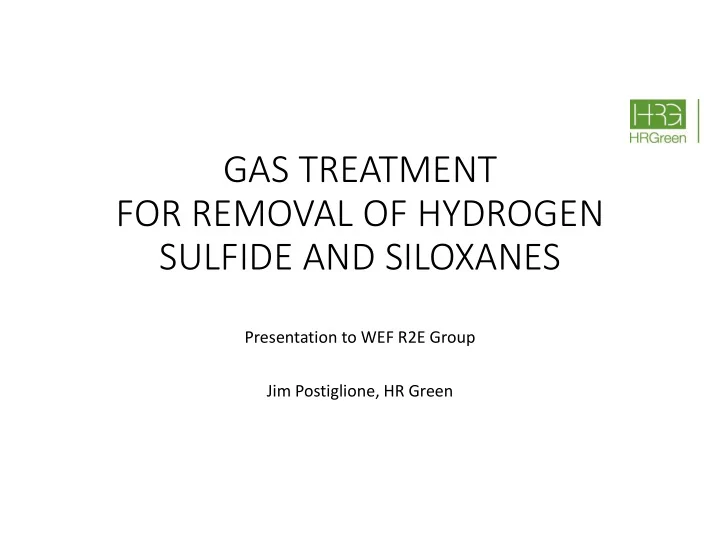

GAS TREATMENT FOR REMOVAL OF HYDROGEN SULFIDE AND SILOXANES Presentation to WEF R2E Group Jim Postiglione, HR Green
HYDROGEN SULFIDE (H 2 S) Notes: Gas Concentrations: Properties: • Heavier than air gas with low • Depends on feed to anaerobic TLV/SEL digester, or wastes accepted at • Liquid/Gas Partitioning: landfill • Present in liquid as an ion or a • Anaerobic digester dissolved gas: concentrations from 100 - • Ka/[H + ] = [HS - ] /[H 2 S] >10,000 ppmv • pKa = 7.1 (25C) • Henry’s Law: • Landfill 50 – 5000 ppmv • [HS-] = K h * P(H 2 S) • K h = 0.1 mol/L-atm
H 2 S REMOVAL TECHNOLOGIES Technologies by H 2 S Loading: • Activated Carbon Adsorption • Chemical Scrubbing • Sacrificial Media • Biological Conversion to Sulfate • Biological Conversion to S o • Proprietary Gas/Liquid Contact • Electrolysis (New)
SACRIFICIAL MEDIA SYSTEMS Media Types: Modeling / Changeout Considerations: • Iron Sponge (Varec, Shand & • Gas flow, H2S concentration and Jurs, …) effluent concentration • Enhanced Fe Sponge (MV Tech) • Gas moisture and oxygen concentration • Iron Oxide Coated Substrate • Form of spent media (loose vs (Sulfa Treat, Axens, …) clumps) • FeOH Media (Unison, Ferrosorp) • Exothermic temperature rise after media removal
H 2 S MEDIA EXAMPLE
BIOLOGICAL TREATMENT SYSTEMS Conversion to Sulfate: Conversion to S o : • Range and variability of loading • Range and variability of loading • Potential polish media for high • Potential polish media for high concentrations and low effluent concentrations and low effluent required required • Neutralization of wastewater • Larger space required • Dilution of product gas (for high • Dewatering of waste, potential inlet concentration) S o reuse
BIOLOGICAL H 2 S TREATMENT
SILOXANE TREATMENT Varying Physical Properties: Degree of Treatment Based on Fuel Use: Vapor Boiling Melting • Medium efficiency Pressure Point Point Compound o F o F Abbreviation MW mmHg, 77F reciprocating engines Trimethylsilyl fluoride 92.19 760 60.8 -101.2 Ethoxytrimethylsilane 118.25 400 165.2 -117.4 • Turbine with recuperator Isopropoxytrimethylsilane 132 • High efficiency reciprocating Propoxytrimethylsilane 132 40.2 214.88 32 Hexamethylcyclotrisiloxane D3 222 10 275 147 engines Octamethylcyclotetrasiloxane D4 297 1.3 348 63 Decamethylcyclopentasiloxane D5 371 0.4 412 -47 • Microturbines Dodecamethylcyclotrisiloxane D6 445 0.02 473 26.6 • CHG / RNG Hexamethyldisiloxane L2, MM 162 31 224 -88.6 Octamethyltrisiloxane L3, MDM 236 3.9 307 -115.6 • Emission control catalyst Decamethyltetrasiloxane L4, MD2M 310 0.55 381 -90.4 Dodecamethylpentasiloxane L5, MD3M 384 0.07 446 -113.8 Trimethylsilanol TMS 90 19 210 10.4 Tetramethylsilane 88.2 11.66 82 -187
TREATMENT OPTIONS Non-Regenerable Systems Regenerable Systems • Activated carbon adsorption • Temperature swing adsorption • Silica gel adsorption • Requires regen flare • Refrigeration systems • Media ranges from activated alumina to molecular sieve • Can be followed by AC or 2 nd • Treatment capacity can be regen system influenced by H 2 S or VOC loading
REGENERABLE EXAMPLES
Recommend
More recommend